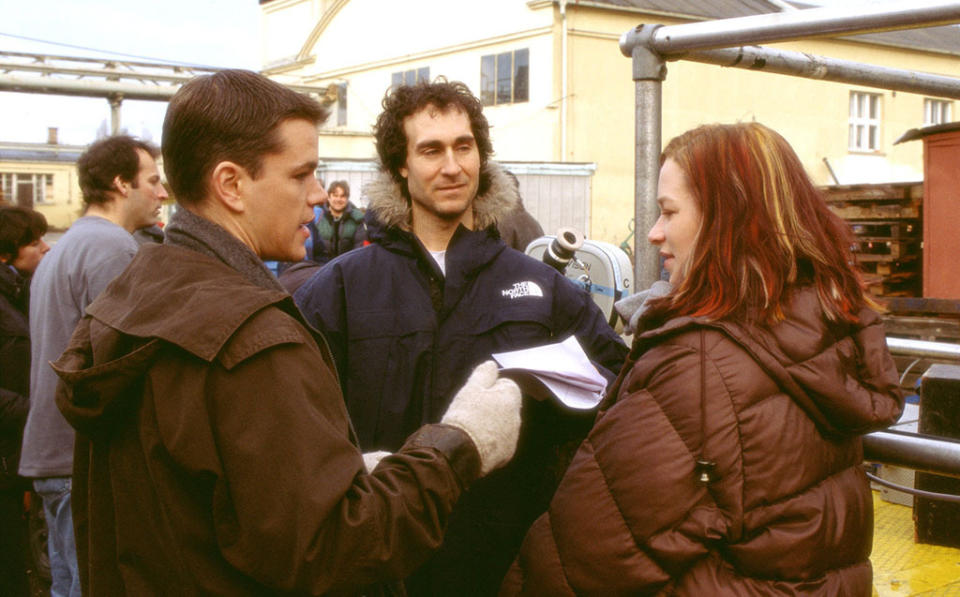How 'The Bourne Identity' Almost Sank the Superspy Franchise Before It Even Started

Matt Damon in ‘The Bourne Identity’ (Universal/Everett)
After nearly a decade away, everyone’s favorite amnesiac superspy returns this weekend in Jason Bourne, the long-awaited fifth installment in a franchise that has so far taken in over $1.2 billion worldwide, reinvented the action film genre, and even won a few Oscars. But Matt Damon & Co. must feel grateful to have gotten this far. That’s because the Bourne franchise was almost dead before it started: The first film, 2002’s The Bourne Identity, was thought by most involved to be a surefire flop — until it hit theaters. How did a near-disaster go on to launch a series that’s lasted 14 years, with five movies and counting?
By the late 1990s, Doug Liman had become one of the hottest directors around, first receiving acclaim with his witty L.A. comedy Swingers, starring Jon Favreau and Vince Vaughn, then with energetic Tarantino-esque thriller Go, starring Sarah Polley and Katie Holmes. And Liman knew what he wanted to make next: an adaptation of a Robert Ludlum spy thriller he’d read in high school called The Bourne Identity, about a man who wakes up with no memory and a microfilm embedded in his hip and eventually learns he’s really a CIA assassin.
Watch the ‘Bourne Identity’ trailer:
Liman flew his own plane (on his first solo flight) to Montana to plead with Ludlum for the rights to the book. (As he would later tell Entertainment Weekly, “I had woefully miscalculated my arrival, so by the time I got there I had the National Guard looking for me.”) His commitment won the best-selling author over, and Liman struck a deal with Universal. “I was intrigued by the pairing of an independent-minded filmmaker with a familiar studio genre,” Stacy Snider, the head of the company, told the Wall Street Journal in 2002. “Look, I’m a moviegoer and I’m bored. I’m getting tired of movies that all look the same.”
After the first draft of the script was rejected, Liman approached Tony Gilroy, writer of The Devil’s Advocate, who read the previous writer’s work. “It was a huge 15-gunmen-on-the-Metro-blowing-the-f—-out-of-everything kind of movie,” Gilroy would later tell The New Yorker. But at its heart, he said, the movie should be “about a guy who finds the only thing he knows how to do is kill people,” which impressed Liman and the studio enough that Gilroy was hired to rewrite the script.

Damon and Franka Potente (Photo: Universal/Everett)
After meeting with a number of actors, including Russell Crowe and Sylvester Stallone, Liman offered the title role to Brad Pitt, who was keen to work with the director. But after a few weeks, Pitt dropped the project in favor of rival espionage thriller Spy Game (co-starring Robert Redford). Next on the list was Matt Damon, and the actor told The Telegraph this week that the call came at just the right time. “I hadn’t had a job offer in six months,” Damon recalled. “All The Pretty Horses had opened, The Legend Of Bagger Vance had opened, and both had underperformed and been critically panned.”
Damon was drawn to Gilroy’s script, which follows the book only in setup, with Bourne waking in the Mediterranean with bullets in his body and no memory of who he is before teaming up with German student Marie (Run Lola Run star Franka Potente) to uncover the truth, as the CIA boss (Chris Cooper) pursues him across Europe with a team of assassins (the most prominent of whom was played by Clive Owen). In fact, Damon was so attached to the script that he nearly walked off the movie when a new writer was brought on to work on the third act of the film. The actor later told Movie Habit that “it became the exact kind of movie that I would pass on, that I don’t want to do and that I avoided doing,” and reportedly threatened to walk unless Gilroy’s version was restored.
But the film’s problems were only just getting started. Liman’s unconventional work habits took their toll: Potente told New York magazine that Liman “freaked me out” at first, and some collaborators labeled him indecisive. “He never knew what he wanted to do,” producer Frank Marshall told the L.A. Times. “He would reshoot some scenes four or five times because he had a new idea.” “I like to keep my options open,” Liman would say in his own defense in New York magazine.
Overruns in budget and schedule soon began to add up, and things weren’t helped when Liman, according to New York, paid the crew overtime to light a forest so he could play paintball. Relationships became increasingly strained, particularly after producers banned the director from reshooting a scene only for the director to go and do it anyway, and eventually communication between the studio and Liman broke down completely. “I would be his surrogate, because at least I could be heard,” Damon said.

Damon, Liman, and Potente (Photo: Universal/Everett)
Extensive reshoots were ordered to add a new action sequence near the end. “I’m not saying I directed the movie,” Frank Marshall told the L.A. Times. “But as the producer, it was my job to get the movie finished.” Liman refuted the idea that he was pushed aside in the same article, saying, “Look at Congo [the 1995 film directed by Marshall] and look at my movies, and let an audience figure out where [Bourne] came from.” He did concede, though, that the final cut was a “collaborative effort.” The director would later claim that Snider had told him he was “never going to work again,” while Matt Damon later told GQ that Gilroy, fearing embarrassment after seeing a rough cut, actually “arbitrated against himself to not be the writer with sole credit … to have another guy take the bullet with him.”
Years later, the director would stand up for himself in an interview with Rolling Stone. “I think they thought that, because it was my third film, they’d be able to bully me.” Liman would say. “Because I had a reporter that was trailing me for a piece and witnessed a lot of this, a story came out that did not portray me in a very favorable light.”
But soon Liman was being looked at in a favorable light after all. The film opened in June 2002, nine months later than originally planned (that might have been a blessing: If it had stuck to the original date, it would have landed soon after the terrorist attacks on Sept. 11). Reviews were good (Variety called it a “first-rate thriller” and Andrew Sarris called it “a rollicking adventure yarn”), and the movie proved to be a sleeper hit, taking $121 million in the U.S. and $214 million worldwide.
A franchise was spawned, and 2004’s The Bourne Supremacy and 2007’s The Bourne Ultimatum built on the foundations of Identity and further brought real-world politics into the spy actioner. Even better reviews and box office followed, with new director Paul Greengrass putting his own stamp on the films (Ultimatum even won three Oscars.) Gilroy was credited with all three scripts and directed the fourth film, 2012’s spin-off starring Jeremy Renner, The Bourne Legacy.
But there was someone missing: Liman, who had only a contractually obliged executive producer credit. The filmmaker has gone on to great success elsewhere, with films like Mr. & Mrs Smith and, more recently, Edge Of Tomorrow. But he still mourned not being able to carry on with Bourne. Years later he would tell New York: “I lost my baby.”
Watch: Matt Damon says Bourne would obviously win a fight with Bond:

